The best trail bike under £500: hit the trails for less than £500
Bike Perfect’s guide to the best sub £500 trail bikes that provide tons of confidence-inspiring control at a very affordable price point
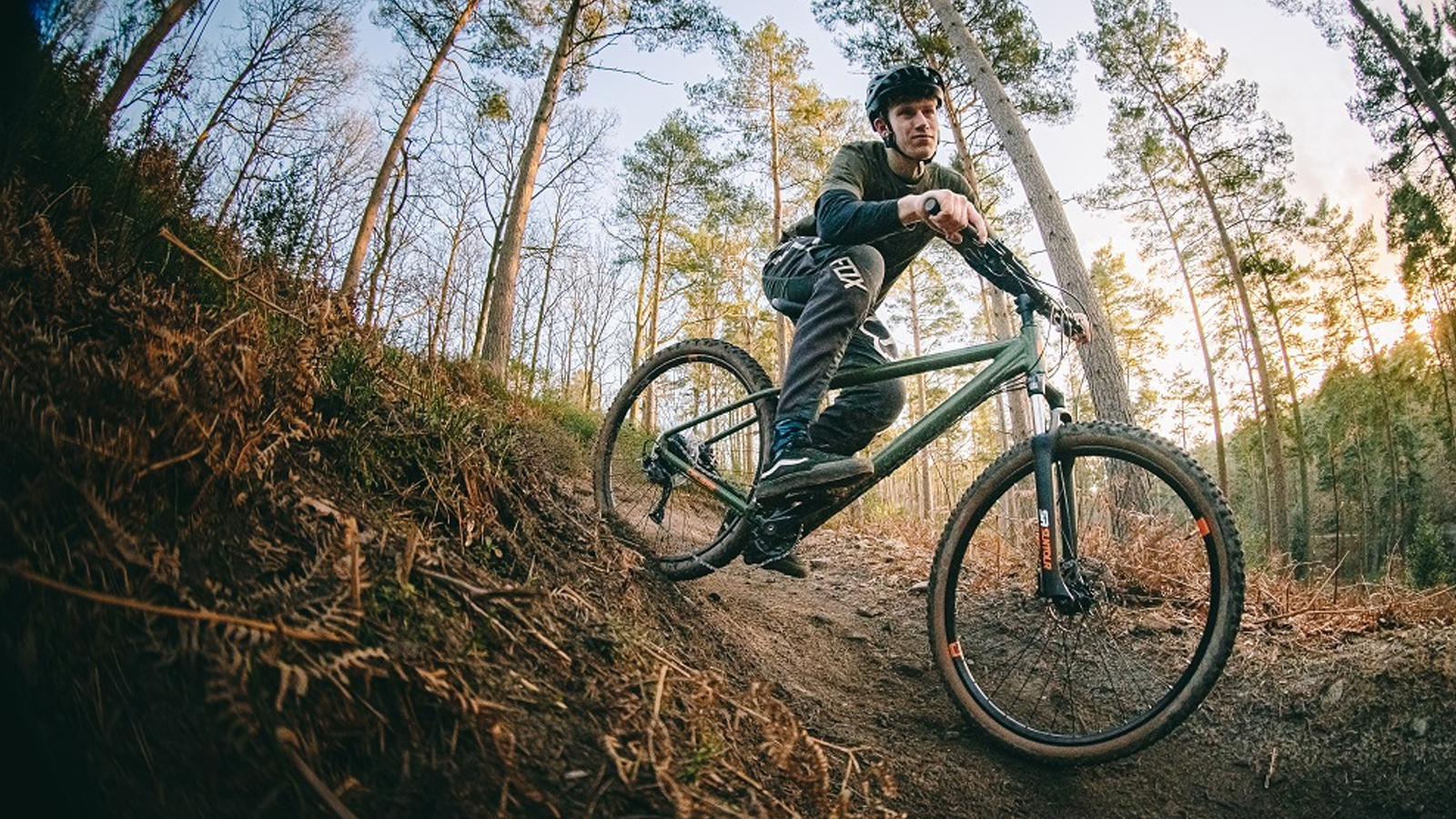
In our opinion, trail bikes at this price point are some of the most important. They’re the gateway to a future of mountain biking, but up until recently, trail bikes under £500 have been more like bike-shaped objects rather than properly fun, confidence-boosting trail rippers. Luckily this has changed and there are now entry-level bikes that provide maximum enjoyment right from the first stepping stone of MTB trail riding.
Thankfully, there aren’t many bad bikes nowadays, and modern entry-level bikes now feature geometry that lets you tackle both technical climbs and gravity-assisted singletrack with confidence. Today’s sub-£500 sleds can even feature hydraulic disc brakes for controlled stopping and wide handlebars for precise cornering.
If you’re unsure of what to look for when purchasing a new sub 500 quid trail bike, then you can skip to our guide on what you need to know about cheap trail bikes. Alternatively, keep scrolling to see our most recommended options.
If you’re looking to spend a little more, check out our best budget mountain bike guide.
If it’s your first bike you’re going to need a helmet too, so make sure to check out our guide to the best mountain bike helmets.
The best trail bikes under £500
Why trust BikePerfect
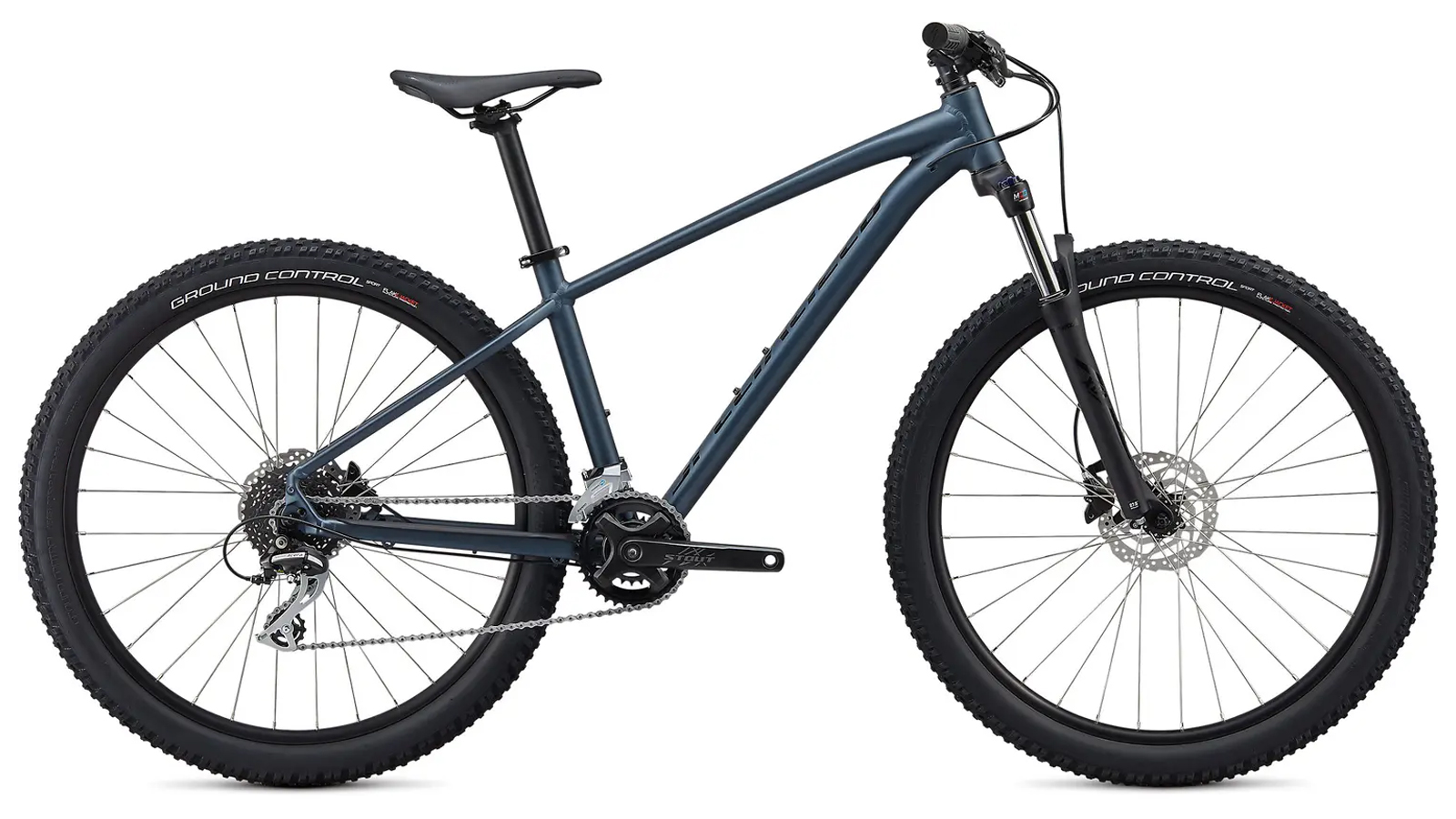
Specialized Pitch Sport
Specifications
Reasons to buy
Reasons to avoid
Combining generous reach measurements across the board, a relatively slack head angle and a wide bar/short stem combo gives the latest Pitch great up to date handling characteristics. The short stem and wide bar provide accurate steering precision across all speeds, and the 68.5-degree head angle tames steeper trails.
Connecting the Pitch to the floor is Specialized’s legendary Ground Control tires, which provide tons of grip on a mixed bag of surfaces and trail conditions. Continuing the theme of control is a set of hydraulic Shimano disc brakes that predictably and reliably manage trail pace in all conditions.
Propelling the Pitch forward is a 2x8 drivetrain with a wide 11-42 cassette. The double front chainrings mean there’s a perfect gear for any gradient and speed. Providing comfort and grip is the coil-sprung SR SunTour suspension fork. Interestingly each frame size gets a different amount of travel. We’re not sure this makes total sense in practice, although it’s said to offer optimum handling for each individual size.
Finished with three killer color options, lock-on grips and fully internally routed cables and hoses gives the pitch a really premium feel. The fact it’s available in lots of retail shops means it can easily be tried for size, too.
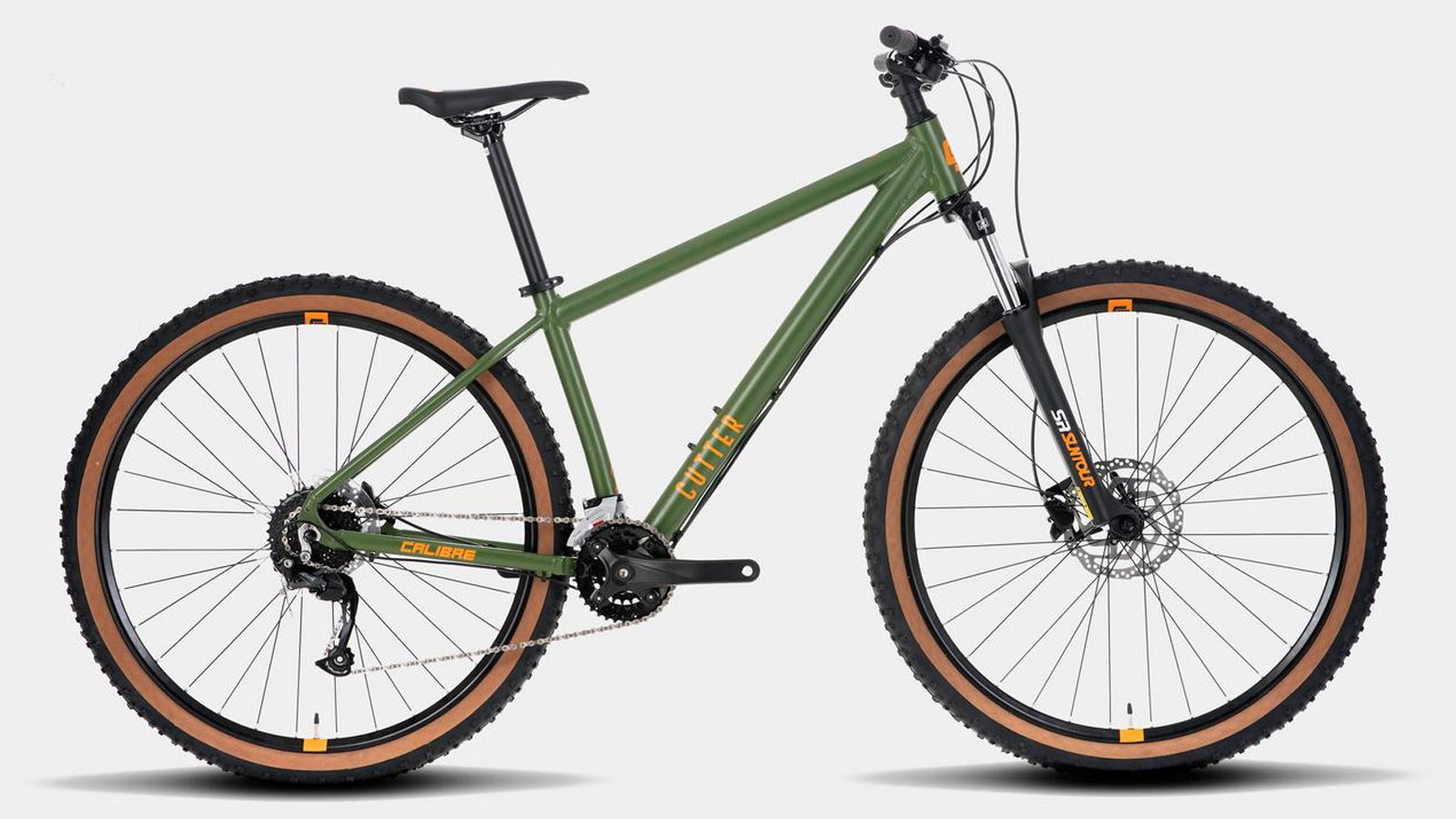
Calibre Cutter
Specifications
Reasons to buy
Reasons to avoid
Calibre is known for making some of the best entry-level bikes on the market, with the Cutter being one of their top performers. Its aim is to provide confident handling on proper mountain bike trails at a bargain price, something it totally nails.
Sporting 29-inch wheels and relaxed frame angles mean the faster-rolling speed from the bigger wheels can be confidently carried through technical sections of trail with ease. A 65mm bottom bracket drop leads to a superbly planted and safe feeling sensation when cornering. With the bottom bracket being so low, you do have to be slightly more careful about pedal strikes when pedaling in technical terrain, however, it’s a worthy trade-off for sublime stability.
The Cutter holds a naturally high trail pace, and luckily, there’s a set of trusty hydraulic disc brakes to keep things well under control. Thanks to the generous 760mm wide handlebar you can put the front wheel exactly where you want it to go. The only thing that lets the Cutter down slightly is the non-branded tires. Even if the tan sidewall does look sick, the overall traction isn’t comparable to big-name brands.
As with most Calibre bikes, the amazing overall ride quality doesn’t match the highly affordable price tag – the handling is comparable to bikes that are twice the price. Plus, if you have a GoOutdoors card you’ll save even more money at the till.
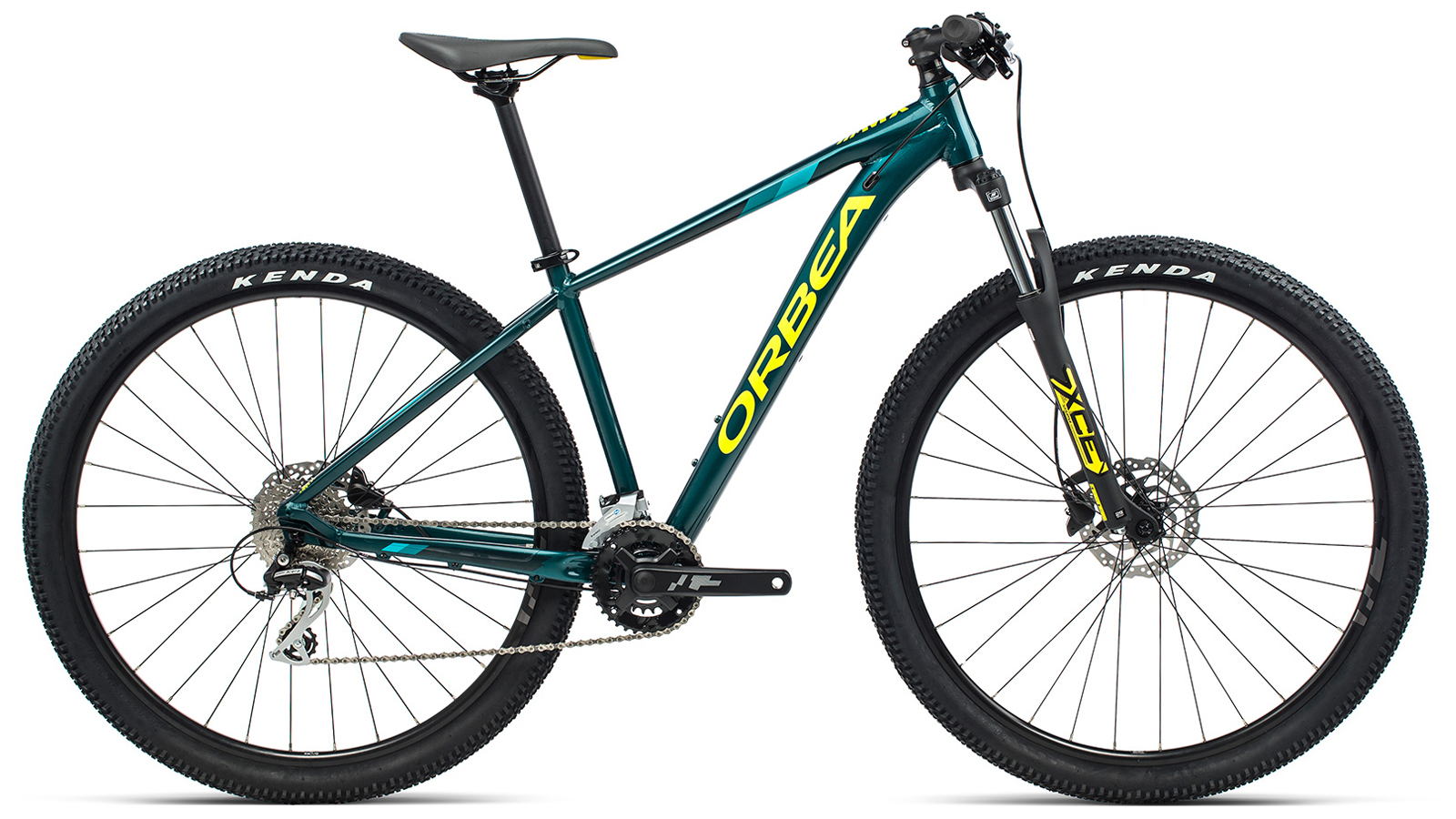
Orbea MX 50
Specifications
Reasons to buy
Reasons to avoid
At 70-degrees, the Orbea MX 50 has the steepest head angle out of all of the bikes on this list, which makes for nimble steering and accurate front wheel placement when threading up testing trail center climbs. There is a drawback, though, and the steeper angles mean noticeably less confidence on steeper terrain, but if you live in a flat region the playful characteristics can enhance on-trail fun.
Depending on frame size, there’s the option for either 27.5 or 29-inch wheels, an option that lets you tailor the handling even further. Covering the wheels is a set of super-fast rolling, low profile Kenda tires, and thankfully, there’s a set of well-modulated Shimano brakes in place to control this energetic speed demon. While basic in construction, the 100mm SR Suntour XCE helps to keep things calm and grippy when the going gets rough.
The geometry does favor riders who value climbing performance over anything else, and adding in the wide 2x8 gear range and lightweight aluminum frame means this bike is a sorted performer in these scenarios. However, if you’re looking to get your fun on the gravity-fed sections of trail, something longer and slacker will be better suited.
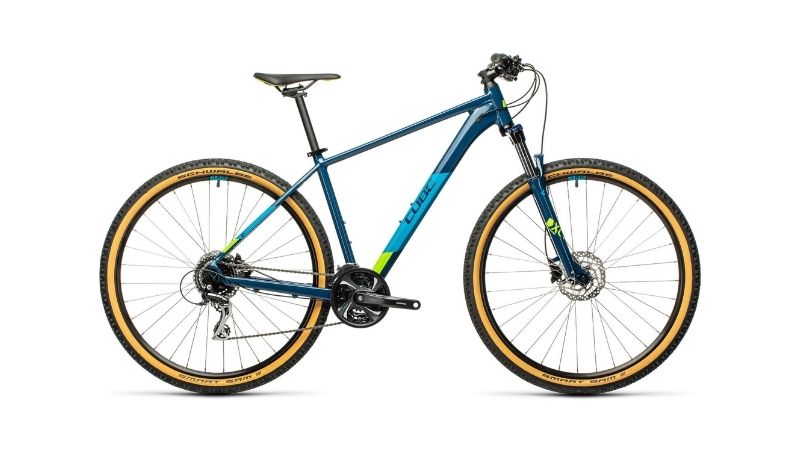
Cube Aim Race
Specifications
Reasons to buy
Reasons to avoid
Cube’s Aim Race uses a more traditional frame shape, which works brilliantly if you’re looking for a bike to use for both tarmac commuting along with some light off-road trail use. Adding to the multi-use party is a 3x8 Shimano drivetrain. The wide range of gear ratios means there are gears for both powering down the tarmac road on the commute and for winching up testing off-road pitches. Although, it is a little more complicated than some of the 1x or 2x options available.
Cube’s mainframe uses a mix of technically shaped tubes, which gives it a really premium feel, especially for an entry-level bike. It actually shares the same frame as many of its much more expensive siblings, meaning just the cheaper components separate it from the top-tier models.
Another neat touch is the handlebar-mounted remote lockout which lets you firm up the well-controlled SR Suntour fork on the fly. This is a great feature if you’re frequently transitioning between tarmac and trails in the same ride. Precise feeling hydraulic Shimano brakes bring things to a controlled stop in all weather conditions.
It’s available in two wheel sizes depending on frame size. This means smaller riders get the benefit of snappier cornering from 27.5-inch hoops, whereas taller riders can take full advantage of fast-rolling 29ers.
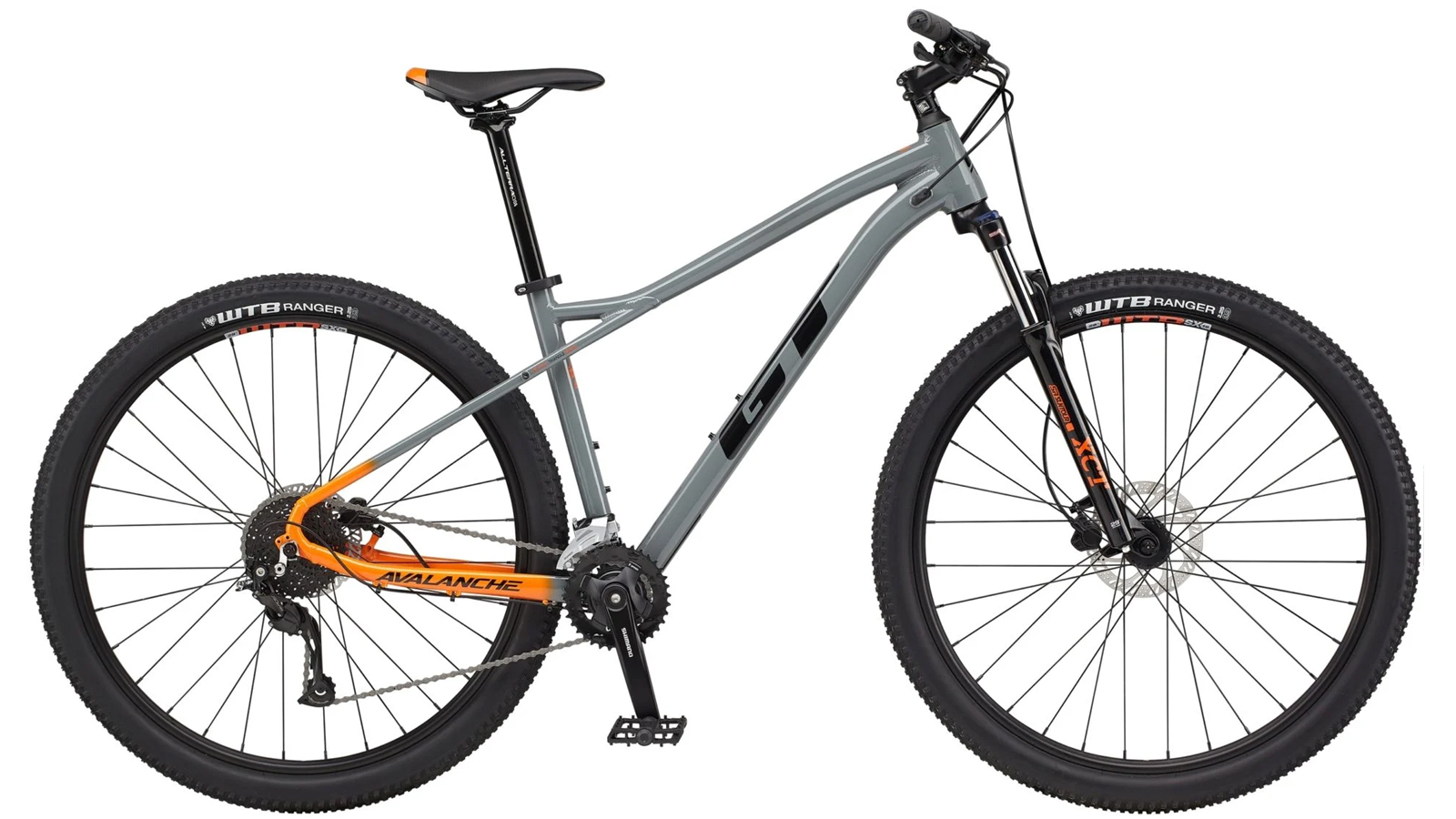
GT Avalanche Sport
Specifications
Reasons to buy
Reasons to avoid
The latest Avalanche Sport from industry legends GT features a lightweight and advanced 6061 T6 aluminum frame construction. Integrated into this sleek-looking frame design is GT’s floating seat stays, which boosts all-day riding comfort. Match this compliant ride with on-trend geometry, and it’s ready for a wide mix of terrain. The frame is also ready to add on a dropper post which is awesome if you’ve got some upgrades in mind further down the line.
We know the frame is sorted, so it just leaves the decision of wheel size. GT offers the Avalanche in both 27.5 and 29-inch formats. If you want a lively ride, we recommend the 27.5-inch wheels, but if out and out speed is your priority 29-inch will be the one.
An SR Suntour coil-sprung fork provides grip and control to the well-treaded WTB tires. Tektro’s M275 hydro disc brakes efficiently control speeds regardless of on trail conditions. A standout feature is a wide range 11-36 cassette. With 18 gears in total, there’s the ideal combination for any scenario.
With everything combined, including the choice of wheel size, if you’re an off-road beginner, the GT’s package is hard to beat.

Rockrider 27.5 ST530
Specifications
Reasons to buy
Reasons to avoid
While we wouldn’t recommend you constantly trash the ST530 around your local graded trails, at a smidge under £350 it’s an absolute bargain if you’re wanting to sample off-road trails for the first time. From blue runs and gravel paths to the weekly commute and first off-road ride, there aren’t many other bikes that are this good of a value with the performance to match.
Taking the simple approach was key during design, and as a result, the Rockrider gets a 1x9 drivetrain. With no front mech, things remain quiet during riding, and the fairly wide range cassette won’t leave you stranded.
Impressively, there are still hydraulic disc brakes front and rear which instantly boost confidence, and the 100mm fork provides just enough travel to keep things under control without transferring unwanted shock when riding.
With geometry that’s been properly considered, a sensible specification list and a wide range of sizes, it’s incredible that this level of composure and fun is available at such an affordable price.
What to know about cheap trail bikes
1. What's a trail bike
In the world of mountain biking, a trail bike is the bike equivalent of a Swiss Army Knife. It’s a bike that’s just as capable on climbs as it is on the downhills, and its component selection is tailored to perform on a wide variety of trails. General trail riding is also a perfect introduction to the world of mountain biking, and today's sub-£500 options are as good as they’ve ever been, meaning new riders or those with a set budget can hit the trails with confidence right from the go.
2. Suspension
To get the best performance in this price bracket we recommend sticking to hardtails – bikes that only feature suspension at the front. In this category, the bike's suspension fork will usually see between 80 and 120mm of travel, with most using coil springs internally. Coil forks are okay but are generally heavier and feature less adjustment and scope for a perfect setup than more expensive air options. That being said, current entry-level coil forks are the best they’ve ever been. A lockout feature is also handy if you’re looking to ride on prolonged sections of tarmac, although it’s not essential on the trail.
3. Geometry
One of the biggest shifts we’ve seen with affordable bikes is geometry. The best entry-level trail bikes no longer see outdated square-like frame angles. A slack head angle, typically between 69 and 66-degrees provides confidence-inspiring and stable handling when descending. It’s also good to look out for bikes with low bottom brackets. While this can make pedal strikes more frequent in technical terrain, this is far outweighed by the added stability when descending. A low BB makes you feel ‘in the bike’, not perched on top of it.
Reach measurement is another frequently spoken about and critical number of a geometry chart. As a rule, shorter bikes are more playful and reactive, whereas longer bikes are more stable and less sensitive to minor bodyweight shifts.
4. Wheel Size
Wheel size is an ongoing debate, but ultimately there is no right or wrong answer. The two most common options nowadays are 27.5 and 29-inch wheels. As a rule, 27.5-inch wheels get up to speed faster and are slightly more reactive on tighter trails, whereas 29-inch wheels maintain speed easier and help to smooth out rough sections of trail.
5. Brakes
Luckily, nearly all of today’s entry-level bikes now feature disk brakes, with the best using hydraulically operated disk brakes. Disk brakes provide consistent braking performance in all conditions, and the lighter lever feel is much more user-friendly. Some bikes may use cable-operated disk brakes and whilst these are a bike improvement over standard rim brakes, we still recommend looking out for hydraulic units.
6. Fit
As with any new bike, making sure you’re riding the correct size is absolutely essential in making sure the overall experience is as enjoyable as it can be. Most manufacturers will include an online size guide, however, if you’re unsure, we recommend visiting a bike shop so you can swing a leg over a few different options to see which fits best.
7. Components
At this price point, there is going to be some compromise when it comes to componentry, so looking for parts that are relatively simple and reliable is key. 1x or 2x drivetrains keep things lighter, simpler and much quieter, and with new wide range cassettes, there are gears for steep pitches and fast descents regardless of how many chainrings you have upfront.
8. Should I look at second-hand?
At this price point, it can be tempting to see if eBay withholds any bargains, however, it’s something we recommend avoiding. Second-hand bikes can be riddled with abuse-related issues, and they also won’t be backed with any kind of after-sales support or component warranties. If you buy from a shop your new bike will come box-fresh, plus if any issues do arise, there’s a point of contact to get them sorted out.
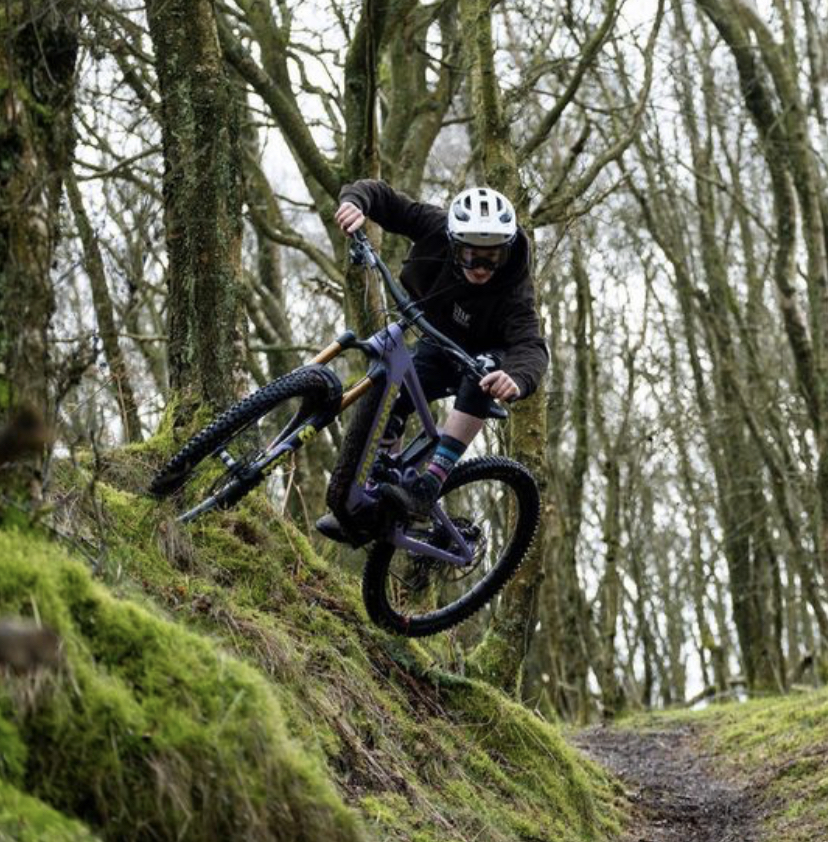
Jim Bland is a product tester and World Cup downhill mechanic based in North Yorkshire, England, but working Worldwide. Jim’s chosen riding genre is hard to pinpoint and regularly varies from e-bike-assisted shuttle runs one day to cutting downcountry laps the next. Always on the hunt for the perfect setup, Jim will always be found comprehensively testing kit with World Cup racing levels of detail. His ultimate day out includes an alpine loam trail, blazing sunshine, and some fresh kit to test.
Rides: Santa Cruz Hightower, Santa Cruz v10, Specialized Kenevo.
Height: 170cm
Weight: 64kg
